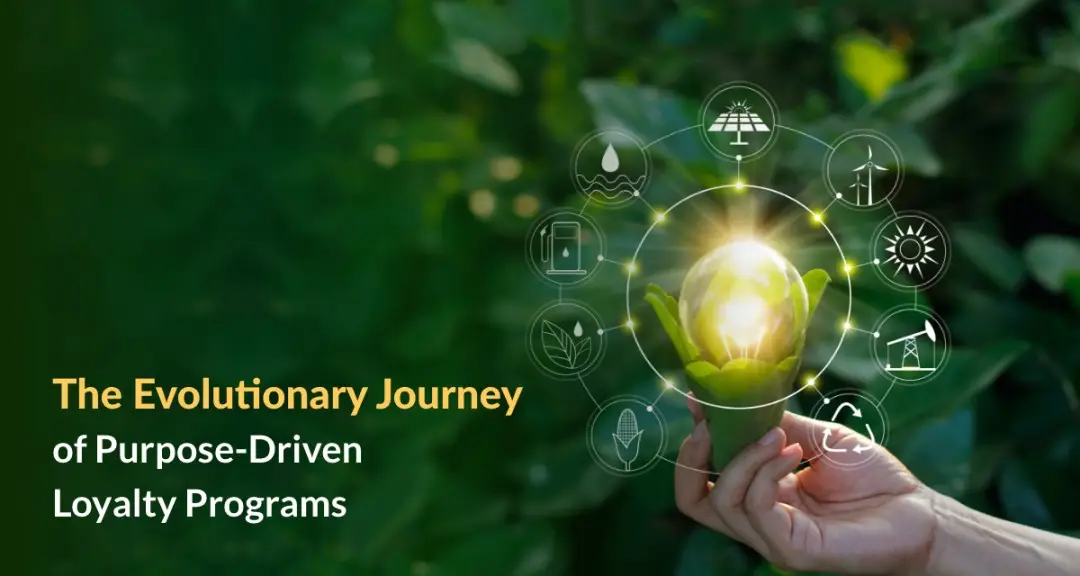According to a study, approximately 44 percent of consumers around the world were considered “purpose-driven consumers.”
Loyalty programs are no longer just transactional tools for customer retention and revenue growth. They have evolved into purpose-driven strategies, aligning a company’s values with its customers. This evolution marks a significant shift from mere points-based incentives to comprehensive programs that resonate with customers’ ethics and societal values, strengthening customer relationships and enhancing brand loyalty.
This blog talks about the journey of loyalty programs, tracing their development from humble beginnings to their current role as key components of business strategies with a broad societal impact. We will explore the transformation of these programs from basic point systems to innovative solutions that shape consumer behavior and brand loyalty and contribute significantly to social and environmental objectives.
What Exactly is a Purpose-Driven Loyalty Program?
A purpose-driven loyalty program is a kind of rewards program that focuses on values and making a positive impact. It is a special type of program where instead of just giving customers points or discounts for buying things, rewards come in the form of actions that help the community, and the environment, or support other good causes.
The idea is to make customers feel good about shopping there because they’re not just getting something for themselves; they’re also helping make the world a better place. This way, customers feel more connected to the business and its values, making them more likely to keep coming back.
Shift to Purpose-Driven Loyalty to Build Deeper Customer Connections
Recent years have witnessed a paradigm shift in loyalty programs, transitioning from purely transactional benefits to purpose-driven models. This evolution goes beyond conventional rewards, aligning loyalty programs with customers’ values, lifestyles, and aspirations. Such purpose-driven approaches foster deeper, more emotional connections with the brand, catering to the growing desire among consumers for meaningful relationships with brands.
Purpose-driven loyalty programs reflect an understanding that today’s consumers seek more than transactions; they want their purchasing decisions to align with their ethical beliefs and personal values. By focusing on rewards, engagement, and recognition that resonate with these values, these programs increase customer loyalty and elevate the brand’s image, appealing to a socially conscious customer base.
Further emphasizing this shift, the structure of modern loyalty programs has become increasingly inclusive and diverse. Today’s platforms allow businesses to design custom rewards programs that cater to various customer preferences and behaviors. These innovative programs might include options for charitable donations, sustainable practices, or community involvement, creating unique experiences that resonate deeply with customers’ values. This progression in loyalty program structure allows brands to differentiate themselves in a crowded market by fostering community building, and social responsibility, offering customers more than just transactional relationships.
Societal Response and Evolving Expectations
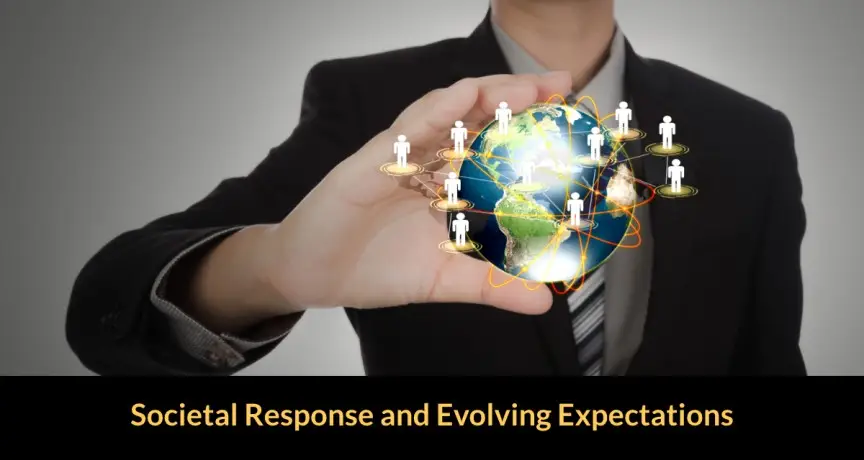
1. Rising Demand for Sustainable Practices:
Consumers increasingly expect loyalty programs to reflect eco-friendly and ethical practices in response to a growing societal emphasis on sustainability. This shift pushes businesses to integrate sustainability into their loyalty strategies, moving beyond traditional rewards to include options contributing to environmental conservation and responsible consumerism.
2. Eco-Conscious Technological Engagement:
Particularly among environmentally aware demographics, there’s a rising preference for loyalty programs that use technology in eco-friendly ways. This includes digital platforms that reduce paper waste, apps promoting sustainable choices, and rewards for eco-conscious behavior. Such tech-driven, environmentally responsible initiatives in loyalty programs are becoming necessary to meet the expectations of a socially and environmentally conscious consumer base.
3. Social and Environmental Consciousness:
A notable trend is the growing emphasis on social and environmental responsibility. Loyalty programs that align with these values and contribute to societal well-being are poised to receive a favorable response from consumers.
4. Deepening Societal Impact:
As we delve deeper into this trend, it’s evident that future loyalty programs are set to transcend traditional reward mechanisms. They increasingly align with societal values and ethical consumerism, reflecting a shift in consumer behavior towards brands that champion social and environmental causes. This evolution leads to creating loyalty programs that are both rewarding, purposeful, and impactful.
7 Benefits of Purpose-Driven Rewards Programs
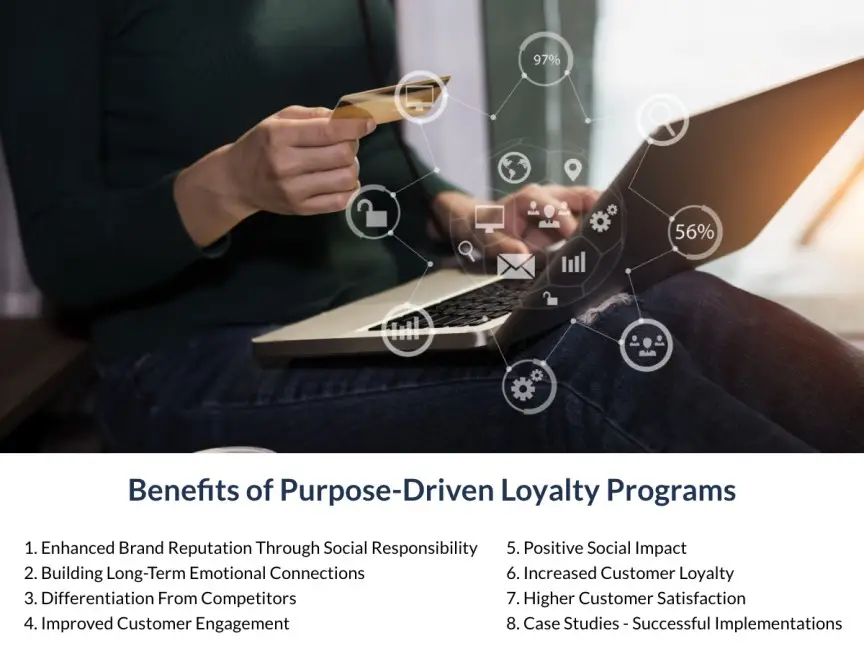
1. Enhanced Brand Reputation Through Social Responsibility
Companies that integrate social responsibility into their loyalty programs often witness a significant enhancement in their brand’s reputation. Demonstrating a commitment to societal and environmental issues allows businesses to showcase their values effectively, leading to improved public perception.
2. Building Long-Term Emotional Connections
Purpose-driven loyalty programs extend beyond mere transactions to cultivate deep emotional bonds between customers and the brand. These programs resonate with the personal values of customers, making them feel part of a community striving for positive change, thereby solidifying their loyalty.
3. Differentiation from Competitors
In a saturated market, a purpose-driven loyalty program can serve as a crucial differentiator. By aligning your brand with a cause, your company can offer something unique that not only attracts customers but also gives them a strong reason to stay engaged.
4. Improved Customer Engagement
Linking loyalty programs to causes or social initiatives increases customer engagement and brand loyalty. This heightened engagement leads to more meaningful interactions, strengthening the customer-brand relationship.
5. Positive Social Impact
Among the most direct benefits of purpose-driven loyalty programs is the positive impact they can have on society. Whether it’s supporting environmental sustainability, aiding communities, or championing other noble causes, these programs enable both brands and customers to contribute to the greater good.
6. Increased Customer Loyalty
Customers are more inclined to remain loyal to brands that mirror their personal values and support causes important to them. Purpose-driven loyalty programs can notably enhance customer retention by emphasizing these values with every purchase.
7. Higher Customer Satisfaction
Lastly, customers who believe their spending is contributing to a cause tend to be more satisfied with their purchases. This satisfaction stems not only from the product or service itself but from the knowledge that their choice is supporting a greater cause.
Impact on Customer Behavior
Purpose-driven loyalty programs have a profound impact on consumer behavior. These programs encourage customers to make choices that align with their values and the brand’s ethos.
For example, a loyalty program that rewards sustainable purchasing practices can influence consumers to opt for eco-friendly products. The analytics capabilities allow businesses to understand and influence these behaviors by tailoring their loyalty programs to match the evolving preferences of their customers, thereby fostering a more sustainable and long-term relationship.
Fostering a Sense of Community Among Members

In addition to sustainability, modern loyalty programs increasingly focus on fostering community among their members. This aspect of loyalty programs goes beyond individual rewards, creating a collective experience that resonates with members on a deeper level. Community-oriented programs encourage customer interaction and engagement, building a shared sense of identity and belonging.
For instance, a loyalty program solution can facilitate community events, forums, or social media groups where customers can connect, share experiences, and engage in brand-related activities. This not only enhances customer loyalty but also turns customers into brand ambassadors. Such community-building initiatives contribute significantly to a brand’s narrative, creating an emotional loyalty that transcends the basic transactional nature of traditional loyalty programs.
Customer Culture Influence of Social Loyalty Programs
- Shaping expectations: Social loyalty programs have significantly influenced consumer culture by shaping expectations and experiences. Customers now anticipate a more tailored and rewarding shopping experience, influenced largely by the perks offered through these programs. Various loyalty platforms, for example, meet these expectations and anticipate future trends, offering customers a dynamic and personalized engagement with brands.
- Behavioral Shifts: These programs have also led to shifts in purchasing behaviors. Customers are more inclined to align with brands that offer economic incentives and align with their values and lifestyles.
Social Responsibility
- Encouraging positive actions: Modern loyalty programs play a significant role in fostering corporate social responsibility. By integrating social and environmental initiatives into their reward systems, businesses can encourage positive actions among their customers. Sustainable loyalty programs, for instance, can include rewards for eco-friendly practices or charitable contributions, effectively aligning business goals with social responsibility.
- Community engagement: These programs also provide a platform for businesses to engage with and give back to their communities. By involving customers in these initiatives, businesses can strengthen their social impact while building stronger customer relationships.
Ethical Considerations in Loyalty Programs
- Data privacy: One of the critical ethical challenges in loyalty program design is data privacy. As these programs collect extensive customer data, ensuring their security and ethical use is paramount. Zinrelo recognizes this concern, implementing robust data protection measures in its loyalty solutions.
- Transparency: Transparency in how points are earned and redeemed is another ethical consideration. Programs must communicate terms to avoid misleading customers, an area where the platform excels by providing clear, concise information.
Purpose-Driven Reward Program Examples
1. Toms Rewards
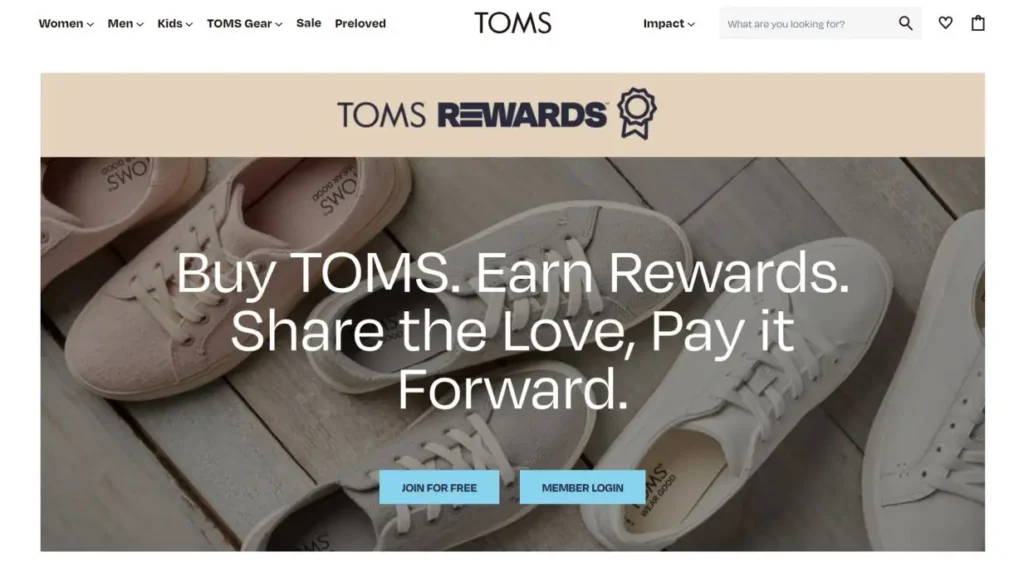
How the Program Works to Drive Customer Loyalty?
Toms also uses its loyalty program to raise awareness of important social issues. For example, Toms launched a campaign called “One Day Without Shoes” to raise awareness of children’s poverty. Toms Rewards members were encouraged to participate in the campaign by going one day without shoes. For every member who participated, Toms donated a pair of shoes to a child in need.
Benefits Offered by Toms Rewards
- Members of Toms Rewards earn points for every dollar they spend on Toms products.
- These points can be redeemed for discounts on future purchases, exclusive products and experiences, or donated to charities.
- Other than purchases, members can earn points for various other activities, such as signing up for newsletters and connecting on social media.
- Customers can redeem the points earned for many exciting rewards like free shipping, access to exclusive products, birthday surprises, etc.
Customer Feedback on the Toms Rewards
TOMS has achieved notable success in creating a community of footwear enthusiasts who value both styles and making a positive impact on the world. Their loyalty program effectively strengthens this connection, ultimately boosting their Customer Lifetime Value (CLV).
2. Adidas – adiClub
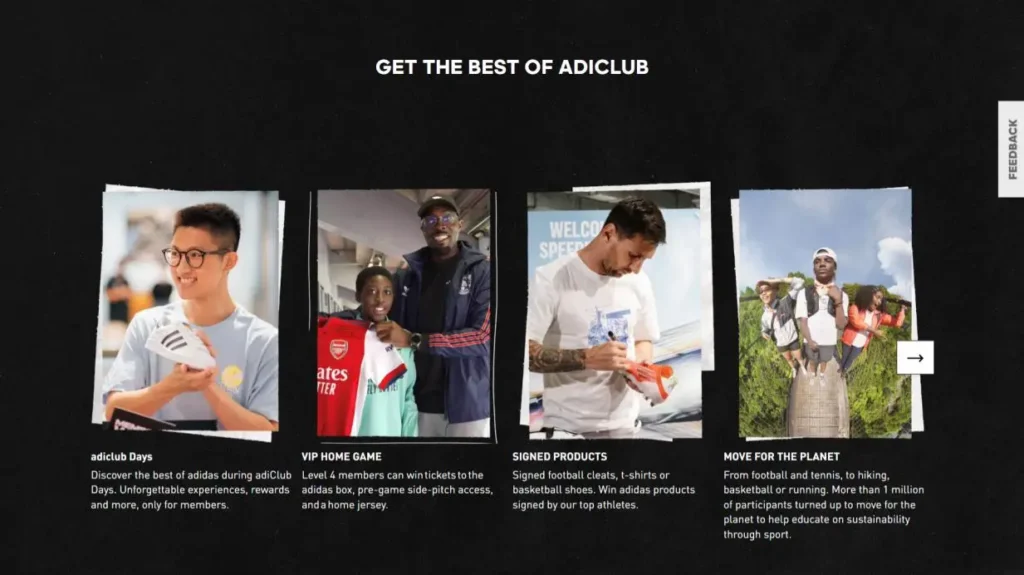
How the Program Works to Drive Customer Loyalty?
The program has four levels, which encourages members to participate more. Adidas has a strong commitment to sustainability. Members could earn points for recycling old Adidas products through the loyalty program. This encouraged responsible disposal of old items and contributed to reducing waste in landfills. The program partners with non-profit organizations to support initiatives that promote diversity, inclusion, and sustainability. Additionally, adiClub members can earn points for completing challenges that support these causes.
Benefits Offered by the Program
- Members get access to exclusive events like Members Week, golden tickets, and train with your hero events.
- The brand also holds charitable campaigns, allowing members to contribute to non-profit organizations.
- the adiClub members enjoy early access to products and can shop limited-edition apparel.
- On reaching level 3, members can enjoy personalization on selected shoes and apparel.
Customer Feedback on the Program and Its Rewards
The program has received a positive response from customers due to its exclusivity, exciting benefits, and commitment to improving the world. The brand is able to connect with its customers on a deeper level by shifting away from the transaction model of loyalty programs. Instead, adiClub actively engages members through events and gamification.
3. Patagonia Rewards Program
How the Program Works to Drive Customer Loyalty?
Patagonia’s loyalty program and ESG efforts are a powerful way to drive customer loyalty. By making customers feel good about their purchases, creating a sense of community, and giving customers a voice, Patagonia is able to build long-term relationships with its customers that are based on shared values.
Benefits Offered by the Program, Including Free Nights and Elite Status
- While Patagonia does not use the traditional point-based loyalty program model, it still offers several amazing benefits to its customers.
- Members get a membership discount allowance, which can be used to purchase Patagonia products.
- The program creates a sense of community, making customers feel part of something bigger than themselves and encouraging them to continue supporting the company.
Customer Feedback on the Program and Its Rewards
Customers appreciate the company’s commitment to sustainability and social responsibility and enjoy the sense of community the program creates. However, some customers would like to see a traditional loyalty program with points and rewards.
4. Credo Beauty’s Recycling Program Promoting Sustainability Through Beauty
Program Overview
Credo Beauty’s recycling initiative allows customers to bring in used beauty products for recycling. In return, they earn loyalty points.
Impact on Consumer Behavior
This program rewards customers and educates them about sustainability in beauty care, encouraging eco-friendly habits.
Program Benefits
Customers contribute to waste reduction and sustainability by participating and earning points that enhance their loyalty and connection to the brand.
5. Plae’s Point Donation Program Empowering Charitable Contributions
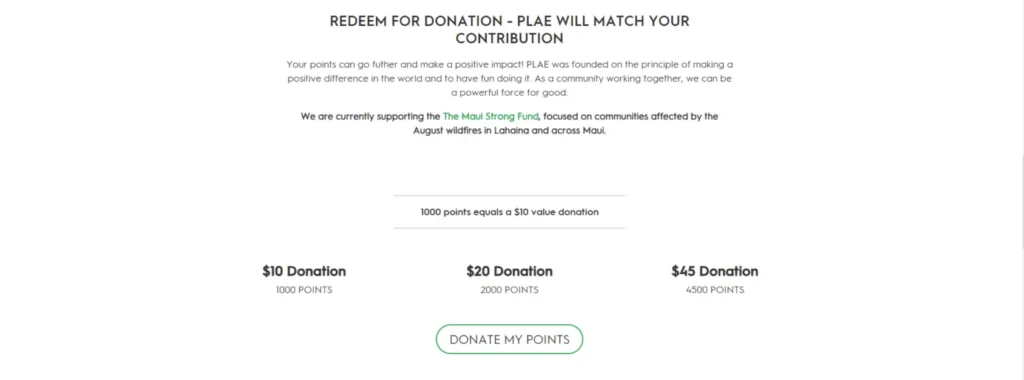
Program Concept
Plae offers a unique option where customers can donate their loyalty program points to support various environmental and social causes.
Encouraging Philanthropy
This program enables customers to engage in philanthropy, aligning their shopping habits with their values.
Program Rewards
While customers don’t receive traditional rewards, the satisfaction of contributing to meaningful causes fosters a strong emotional connection with the brand, enhancing customer loyalty.
These future programs are expected to incorporate carbon offsetting for travel-related rewards or supporting social justice initiatives, aligning loyalty for business growth with social impact. By intertwining loyalty programs with these societal changes, businesses can cultivate deeper connections with customers and foster brand loyalty rooted in shared values and ethical practices.
The global loyalty programs of the future will likely transform from mere business strategies to powerful tools for positive societal impact, aligning customer loyalty with global sustainability and social responsibility goals.
Conclusion
The evolution of loyalty programs from basic point-based systems to sophisticated, purpose-driven strategies represents a significant shift in customer engagement and business strategy. Once straightforward mechanisms for customer retention, these programs have now become integral elements in shaping consumer behavior, business growth, and, importantly, societal trends. Today, these programs are not just about customer retention and business growth; they are increasingly about aligning with customers’ ethical and environmental values. This alignment is crucial in today’s market, where consumers are more conscious of the societal and environmental impact of their purchasing decisions.
Key Takeaways and Actionable Steps
- Evolution from personal to digital: Transitioning from personal connections in local markets to digital, data-driven strategies, enhancing personalized customer experiences.
- Shift to purpose-driven models: Moving beyond transactional benefits to align with customers’ values and lifestyles, fostering deeper connections and societal impact.
- Role of technological advancements: Utilizing advanced technology and data analytics to make loyalty programs more personalized, efficient, and engaging.
Ready to Build Your Loyalty Program With Zinrelo?
Learn how our holistic loyalty platform can transform your business.
Related Questions
1. What is a Purpose-Driven Loyalty Program?
Purpose-Driven loyalty programs align business values with customers’ desires to support social or environmental causes. Offering rewards for backing these causes fosters a deeper connection and meaning between businesses and customers.
2. How do loyalty program rewards work in the context of purpose-driven initiatives?
Rewards in purpose-driven programs can vary from traditional points and discounts to more meaningful rewards like donations to charities, support for sustainability efforts, or community engagement initiatives. This approach helps brands align rewards with customers’ values and interests.
3. What are the benefits of implementing a Purpose-Driven Loyalty Program?
Such programs offer numerous benefits including differentiation from competitors, increased customer engagement, a positive brand image, unique marketing opportunities, and enhanced customer loyalty, as they position the brand as a force for good.
4. How can Purpose-Driven Loyalty Programs impact customer satisfaction and loyalty?
By offering rewards that resonate with customers’ personal values and contributing to causes they care about, these programs improve customer satisfaction. They make customers feel valued and understood, which in turn, fosters loyalty.
5. What types of businesses can benefit from Purpose-Driven Loyalty Programs?
Any business can benefit, especially those looking to align their brand with ethical practices, sustainability, and community support. These programs are particularly effective for businesses whose customer base values social responsibility.
6. How can businesses implement Purpose-Driven Loyalty Programs effectively?
To effectively implement these programs, businesses should integrate their core values into the loyalty program’s structure, offer personalized and meaningful rewards, and leverage customer data for tailored marketing strategies.
7. Can Purpose-Driven Loyalty Programs also support business growth and profitability?
Yes, by fostering a positive brand image and deepening customer engagement, these programs can drive business growth. They attract like-minded customers and encourage repeat business, contributing to long-term profitability.
8. How do Purpose-Driven Loyalty Programs align with modern consumer expectations?
Today’s consumers increasingly seek brands that contribute positively to society. Purpose-driven loyalty Programs meet these expectations by offering rewards that go beyond transactional benefits, thereby aligning with modern values and consumer demands.
